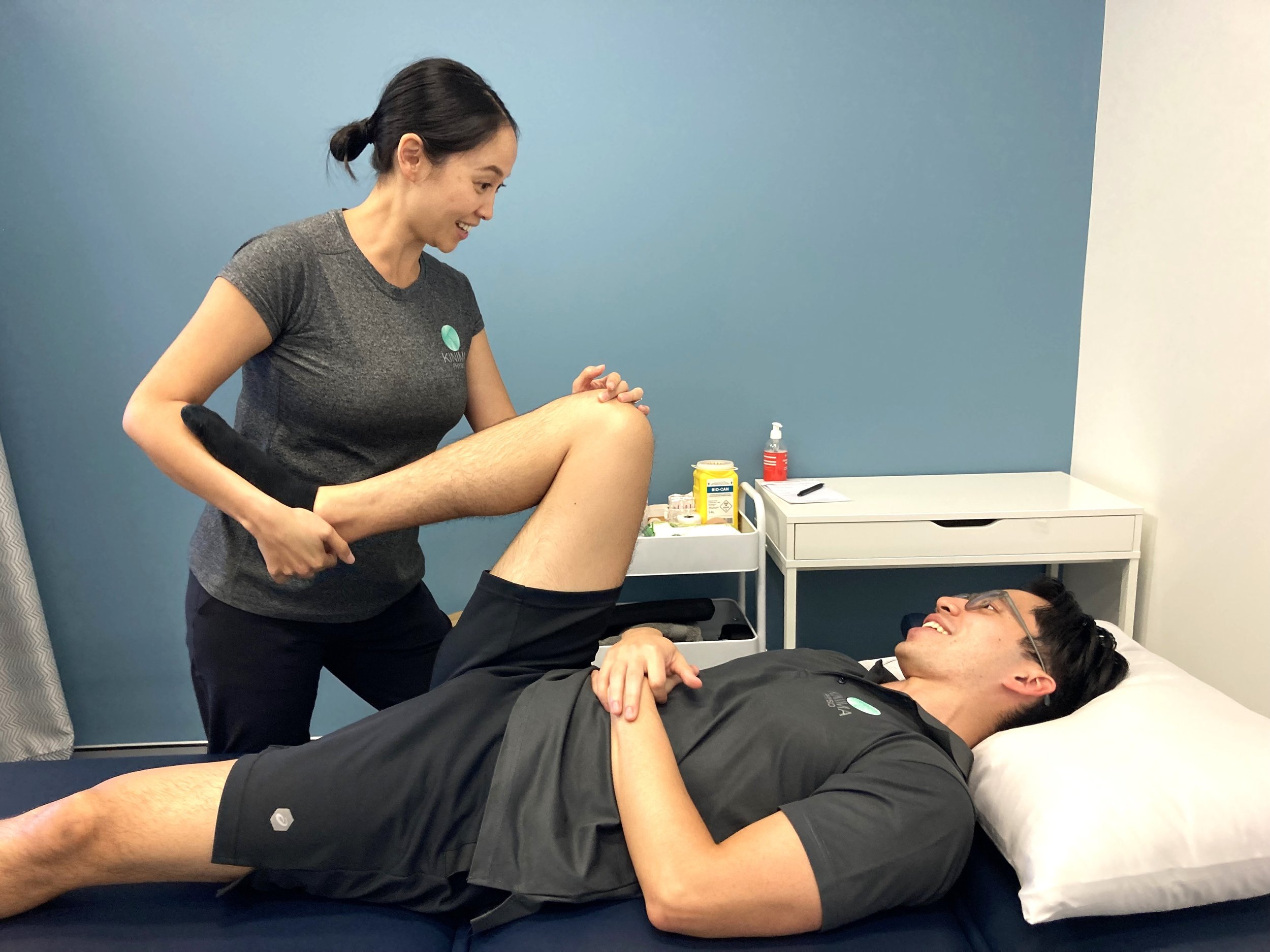When to see a Physio for Knee Pain?
Knee pain is one of the most common areas of the body to experience pain and injury. It can impact athletes and everyday people and is difficult to know when you should see a physiotherapist. There are many factors that may contribute to knee injuries. Some of these factors are modifiable such as training load or body mass, and others being non-modifiable such as skeletal anatomy or genetics.
Common causes of knee pain:
· Increase or decrease in training load
· Weak lower limb and trunk muscles
· Tight hip, knee and leg muscles
· Poor skill or technique of an activity or sport
· Combination of lack of sleep, inadequate nutrition, and increased stress
· High body mass for height
· Reduced cardiovascular fitness
· Genetics and anatomy
There are a wide variety of conditions which cause pain in and around the knee and can impact a large variety of structures such as the main knee joint, patella (knee cap), knee cartilage, ligaments, muscle, tendons, fascia, capsule, bursa, nerves. Sometimes pain in the knee can be referred by an injury to the hip or lumbar spine (lower back).
Common knee pain issues:
· Patellofemoral joint syndrome (knee cap pain)
· Knee osteoarthritis
· Iliotibial band (ITB) friction syndrome
· Medial and lateral meniscus tears
· Medial and lateral collateral ligament sprains or tears
· Anterior cruciate ligament (ACL) tear
· Quadriceps patella tendinitis or tendinopathy
· Patella or knee cap dislocation
· Patella chondromalacia
· Hamstring muscle injuries and tendinopathy
· Upper calf strains and tears
· Osgood Schlatter’s disease (growth plate)
· Sinding Larsen Johansson syndrome (growth plate)
Knee pain symptoms can range from a mild niggle, clicking, or feeling of tightness around the knee to the more alarming symptoms such as severe pain, knee instability/giving way, or throbbing pain at rest.
Common knee pain symptoms
· Deep knee joint stiffness and swelling (usually worse first thing in the morning)
· General constant aching
· Reduced range of movement of the knee (bending or straightening)
· Sharper pain around the knee cap when loading (walking, stairs, squatting, running)
· Knee feels weak all of a sudden
· Knee catches, locks or a feeling of giving way
· Pain that increases later in the day/night and while resting
· Deformity, redness, and warmth of the knee
· Persistent knee pain lasting longer than 48 hours
Should I see my doctor or physio for knee pain?
A physiotherapist can assess knee conditions, provide a provisional diagnosis/prognosis, offer evidence-based pain relief techniques, provide guidance, support function, and suggest strategies to manage symptoms. The earlier this is carried out, the earlier a knee condition can be progressed through rehabilitation and recovery. Very often, your doctor will refer you to a physiotherapist to best manage most knee pain conditions. Your physiotherapist will know very quickly whether medical intervention, imaging, onward referral is required.
You should seek urgent medical attention at the closest emergency department if there has been a high speed injury, there is uncontrollable pain or bleeding, or if there is evidence of fracture or joint deformity/dislocation.
Is physiotherapy good for knee pain?
The goal of physiotherapy is to first rule out any red flags, which is screening for evidence that there is something else driving the knee pain that needs urgent attention. This includes unrelenting extreme pain, fracture, deformity, suspicion of cancer, suspicion of other inflammatory/auto-immune disorders. This can be done by questioning, screening forms, and early observation and assessment. Once red flags are out of the equation the physiotherapists goal is to support the injured area, restore range of motion of the knee, and de-sensitise the knee from any acute pain symptoms. Once the knee is moving well and calmed down from as much pain, the goal is to improve the knees capacity to withstand load. This is usually in the form of improving the knee and surrounding joint coordination, balance, endurance and strength. Building a more robust knee and surrounding joints aims to support the injured area, improve function, and reduce the likelihood of future problems. See our Top 5 Tips for Preventing Knee Pain.
When should I see a physiotherapist for knee pain?
If you have a new knee injury or ongoing/recurrent pain around the knee, book a thorough assessment with one of our physiotherapists. By reviewing your history and analysing assessment findings, they can provide a provisional diagnosis and realistic prognosis. This helps guide a personalised treatment plan to support your recovery and goals.
It is always recommended to seek help from a physiotherapist as soon as possible as longer term musculoskeletal conditions may generally take longer to fully recover.
If you are currently seeking treatment with another health professional and not sure if it’s helping, read our latest blog to find out “Is your physiotherapist providing best practice care?”
What does a physio do for knee pain?
There are many treatment and management strategies a physiotherapist employs for knee pain and knee injuries. Here are the most common, effective and evidence-based options:
· Education & providing information
Knowledge is power! Your physiotherapist will explain the diagnosis, causes, recovery times, things to do more of, things to do less of, and upcoming treatments/exercises that will support recovery. This very important knowledge helps you gain clarity, confidence and empower you to overcome your limitations of the knee pain and injury.
· Activity modification & load management
With a lot of knee conditions, it is vital to temporarily modify activity to reduce pain, inflammation, and irritation of the injured structures. This may include avoiding climbing stairs for a couple of weeks or reducing running distance and frequency by 50%. Some low-level pain is generally ok with activity, as long as it settles in a reasonable time afterwards.
· Knee support strategies: crutches, bracing, strapping
In the early or very painful stages of a knee injury, you may greatly benefit from supporting the knee. This can come in various forms such as the use of crutches to significantly offload the knee, bracing to restrict certain knee movements, and sports strapping or dynamic tape. Our physiotherapists will be able to guide you with the most appropriate support strategies for you.
· Swelling and pain reduction
Swelling in and around the knee is an indication of an increase in inflammation which brings along with it an increased pain experience. It is important to contain and reduce the swelling as soon as possible for a quicker knee injury recovery. Our experienced physiotherapists have many strategies in their tool kit to help alleviate pain and swelling for knee pain conditions. Learn more about swelling via our latest blog “What does swelling mean?”
· Increase range of motion
When your physiotherapist is assessing your knee, they will be looking for any reduction in knee range of motion which is commonly found with acute injury or osteoarthritis. Additionally, your physiotherapist will be looking for reductions in range of motion at the hip and foot/ankle. Restoring the range of motion of the knee and lower limb can improve balance, pain, swelling, and overall function.
· Soft tissue release techniques
Your physiotherapist may identify muscle length deficits or tightness on those muscles that attach to the knee. Treatment strategies such as massage, trigger point release, dry needling, and PNF techniques are commonly used to restore muscle length.
· Muscle performance & development
Even a small amount of swelling and pain in and around your knee can cause a detrimental effect to your knee muscle performance (especially the quadriceps). Your physiotherapist will prioritise improving activation and endurance of the quadriceps, hamstring, gluteal, and calf muscles while limiting pain. Once pain is settled then the focus usually shifts to improving function such as squatting, lifting, climbing stairs, walking, jogging, and playing sport. See our gentle strengthening exercises for the knee below:
· Rehabilitation pre-surgery & post-surgery
Physiotherapy can play a very important role following a knee surgery. Your specialist will indicate when you can commence rehabilitation following your operation. Post-operative outcomes are optimised when exercise therapy is performed in the weeks/months prior to planned knee surgery.
If you’ve had ACL surgery recently, learn the Early Phase ACL Rehab Goals you will need to achieve.
Wrapping up knee pain
Knee pain and injuries cause high disability, lower quality of life, and prove costly to society. They can be a major cause of frustration and can prevent you from doing basic daily activities and the activities you love.
As there are many different types and causes of knee pain and injury, it is important to ascertain the correct diagnosis and receive an individualised action plan from one of our physiotherapists. Once treatment and management are started, many people notice improvements over time.
You can book a knee assessment to discuss your symptoms with one of our physiotherapists.



